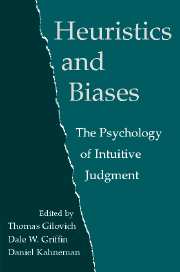Book contents
- Frontmatter
- Contents
- List of Contributors
- Preface
- Introduction – Heuristics and Biases: Then and Now
- PART ONE THEORETICAL AND EMPIRICAL EXTENSIONS
- PART TWO NEW THEORETICAL DIRECTIONS
- 22 Two Systems of Reasoning
- 23 The Affect Heuristic
- 24 Individual Differences in Reasoning: Implications for the Rationality Debate?
- 25 Support Theory: A Nonextensional Representation of Subjective Probability
- 26 Unpacking, Repacking, and Anchoring: Advances in Support Theory
- 27 Remarks on Support Theory: Recent Advances and Future Directions
- 28 The Use of Statistical Heuristics in Everyday Inductive Reasoning
- 29 Feelings as Information: Moods Influence Judgments and Processing Strategies
- 30 Automated Choice Heuristics
- 31 How Good Are Fast and Frugal Heuristics?
- 32 Intuitive Politicians, Theologians, and Prosecutors: Exploring the Empirical Implications of Deviant Functionalist Metaphors
- PART THREE REAL-WORLD APPLICATIONS
- References
- Index
30 - Automated Choice Heuristics
from PART TWO - NEW THEORETICAL DIRECTIONS
Published online by Cambridge University Press: 05 June 2012
- Frontmatter
- Contents
- List of Contributors
- Preface
- Introduction – Heuristics and Biases: Then and Now
- PART ONE THEORETICAL AND EMPIRICAL EXTENSIONS
- PART TWO NEW THEORETICAL DIRECTIONS
- 22 Two Systems of Reasoning
- 23 The Affect Heuristic
- 24 Individual Differences in Reasoning: Implications for the Rationality Debate?
- 25 Support Theory: A Nonextensional Representation of Subjective Probability
- 26 Unpacking, Repacking, and Anchoring: Advances in Support Theory
- 27 Remarks on Support Theory: Recent Advances and Future Directions
- 28 The Use of Statistical Heuristics in Everyday Inductive Reasoning
- 29 Feelings as Information: Moods Influence Judgments and Processing Strategies
- 30 Automated Choice Heuristics
- 31 How Good Are Fast and Frugal Heuristics?
- 32 Intuitive Politicians, Theologians, and Prosecutors: Exploring the Empirical Implications of Deviant Functionalist Metaphors
- PART THREE REAL-WORLD APPLICATIONS
- References
- Index
Summary
In his Nobel Prize address, Herbert Simon urged choice theorists to stop pretending that actual choices can be predicted from theoretical models of optimal choice. He argued that any descriptively adequate account of human decision making must make contact with the actual psychological processes that are involved and that “the neoclassical ambition of avoiding [this] necessity is unrealizable” (1978, p. 507).
Many choice theorists have taken up Simon's challenge. They have sought to identify the various “heuristics” people use to simplify choice – the procedures they use to limit the amount of information that is processed or the complexity of the ways it is combined. In a prototypical study, a respondent might be asked to make several hypothetical choices among apartments, whose attributes (e.g. monthly rent, miles from work, square footage) are listed as rows of numeric values (e.g. $560, 12, 900, respectively). The respondent's choice processes are then either inferred from the choices she makes or are more directly observed through “process tracing” methods that use computerized displays to track the attributes and options that the respondent considers, the order in which they are considered, and, sometimes, the time spent pondering each piece of information.
On the basis of process tracing methods, verbal protocols, introspection, and theory, many different choice heuristics have been postulated (for reviews, see Payne, Bettman, & Johnson, 1993; Gigerenzer, Todd, & the ABC Group, 1999; Gigerenzer, Czerlinski, & Martignon, Chapter 31, this volume; Gigerenzer & Goldstein, 1996).
- Type
- Chapter
- Information
- Heuristics and BiasesThe Psychology of Intuitive Judgment, pp. 548 - 558Publisher: Cambridge University PressPrint publication year: 2002
- 46
- Cited by



